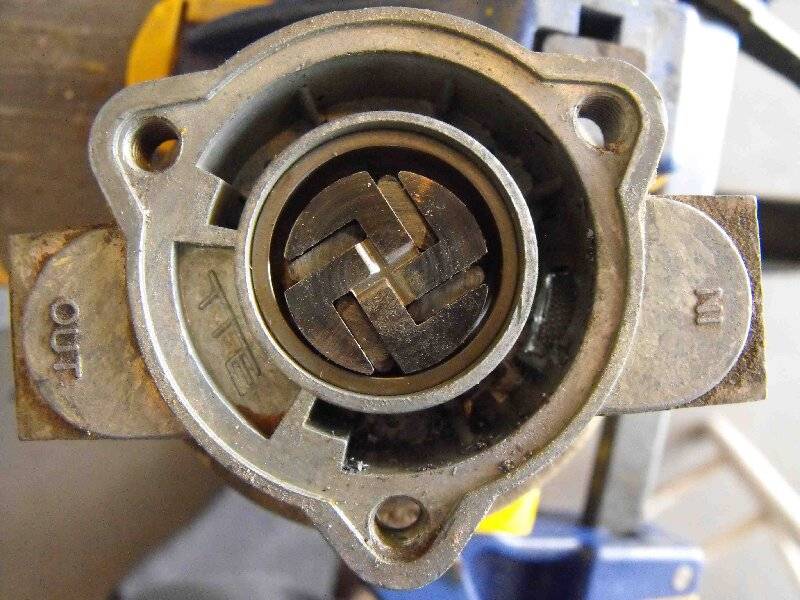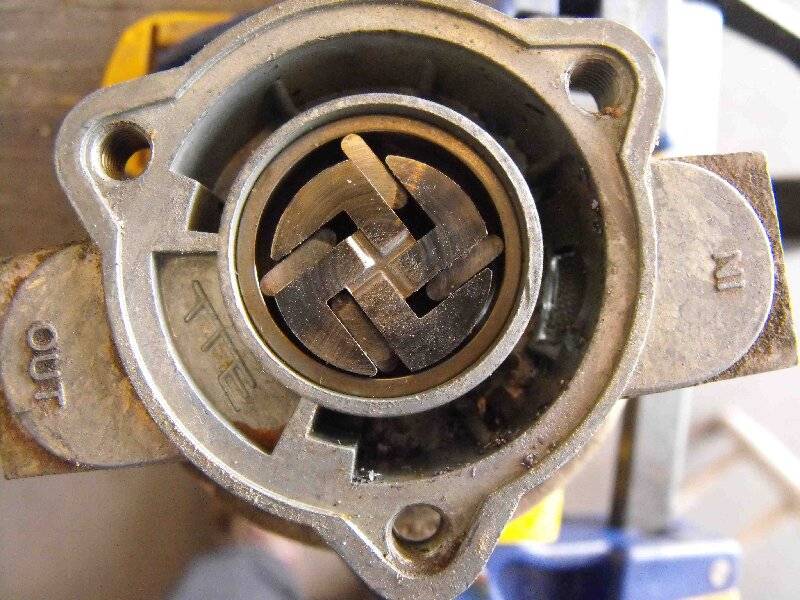Re: Motor suddenly dying
Posted by DavidPackard On 2023/4/29 11:40:49
Ross, here’s something Paul Harvey couldn’t do . . . provide a picture or two.
The following are photos of a Carter rotary vane pump with the end cap removed. From this view pump rotation would be CCW, with the flow path starting at 03:00 and continuing to 09:00. The outer partial ring is the fluid inlet cavity, which held the screen protecting the pump from tank debris.
Photo – PumpVanesIn shows all of the vanes fully retracted into the driven element. In this position the engine mechanical fuel pump would draw fuel through the Carter pump.
Photo – PumpVanesOut shows the other extreme of vane position. This would be the positions as the pump is running. Note the cavity between the vanes at 12:00 and 03:00, which would rotate CCW to the outlet passage. If the vanes achieve this position when the pump is not running the engine mechanical fuel pump would not draw fuel.
It is centrifugal force that forces the tip of the vane to follow the circular outer wall of the pump. When the pump is not running the vanes shown at essentially 12:00 and 03:00 are free to move. If they happen to move inward away from the outer wall then the engine mechanical pump will likely function properly. If the either vane is very near the outer wall the mechanical pump will lose capacity and will be more susceptible to ‘vapor lock’. There are no springs to bias the static position of the vanes.
It’s a personal choice whether to install an e-pump for pre-start priming, but infrequent use of the car and storage in a hot climate are factors that influence the choice. I agree with TxGoat’s assessment that, when new, these cars didn’t need e-pumps, and his observation that a fine filter should never be placed on the inlet side of a pump is 100% correct. Typically coarse mesh screens are used on the inlet side.
It sounded from Packard51’s first posting that his car mysteriously stopped running after a significant amount of time running well. He also mentioned an e-pump was installed in the car. If this is an intermittent condition the best plan is to investigate the fuel/spark/air basics, as BigKev stated. Packard51’s problem could easily be carburetor related, and be a gross flooding condition because the needle and seat fuel valve is stuck in the full open position, which if that’s the case, turning on the e-pump is the last thing you would want to do. I would approach the problem one system at a time . . . I’ve been tricked thinking a fuel problem was electrical ( and the other way around ) several times in my life, so Packard51 try to use a methodical approach.
dp
Attach file:
 PumpVanesIn.JPG (236.07 KB)
PumpVanesIn.JPG (236.07 KB)

 PumpVanesOut.JPG (259.44 KB)
PumpVanesOut.JPG (259.44 KB)

The following are photos of a Carter rotary vane pump with the end cap removed. From this view pump rotation would be CCW, with the flow path starting at 03:00 and continuing to 09:00. The outer partial ring is the fluid inlet cavity, which held the screen protecting the pump from tank debris.
Photo – PumpVanesIn shows all of the vanes fully retracted into the driven element. In this position the engine mechanical fuel pump would draw fuel through the Carter pump.
Photo – PumpVanesOut shows the other extreme of vane position. This would be the positions as the pump is running. Note the cavity between the vanes at 12:00 and 03:00, which would rotate CCW to the outlet passage. If the vanes achieve this position when the pump is not running the engine mechanical fuel pump would not draw fuel.
It is centrifugal force that forces the tip of the vane to follow the circular outer wall of the pump. When the pump is not running the vanes shown at essentially 12:00 and 03:00 are free to move. If they happen to move inward away from the outer wall then the engine mechanical pump will likely function properly. If the either vane is very near the outer wall the mechanical pump will lose capacity and will be more susceptible to ‘vapor lock’. There are no springs to bias the static position of the vanes.
It’s a personal choice whether to install an e-pump for pre-start priming, but infrequent use of the car and storage in a hot climate are factors that influence the choice. I agree with TxGoat’s assessment that, when new, these cars didn’t need e-pumps, and his observation that a fine filter should never be placed on the inlet side of a pump is 100% correct. Typically coarse mesh screens are used on the inlet side.
It sounded from Packard51’s first posting that his car mysteriously stopped running after a significant amount of time running well. He also mentioned an e-pump was installed in the car. If this is an intermittent condition the best plan is to investigate the fuel/spark/air basics, as BigKev stated. Packard51’s problem could easily be carburetor related, and be a gross flooding condition because the needle and seat fuel valve is stuck in the full open position, which if that’s the case, turning on the e-pump is the last thing you would want to do. I would approach the problem one system at a time . . . I’ve been tricked thinking a fuel problem was electrical ( and the other way around ) several times in my life, so Packard51 try to use a methodical approach.
dp
Attach file:
 PumpVanesIn.JPG (236.07 KB)
PumpVanesIn.JPG (236.07 KB)
 PumpVanesOut.JPG (259.44 KB)
PumpVanesOut.JPG (259.44 KB)
This Post was from: https://packardinfo.com/xoops/html/modules/newbb/viewtopic.php?post_id=256349